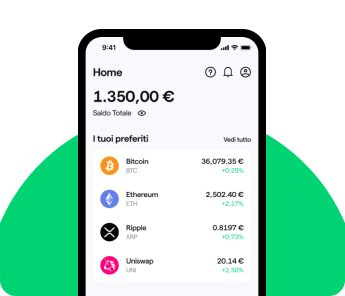Young Platform
Keep track of your wallet’s performance with Young Platform’s new Profit and Loss feature
Jacqueline Nieder
7 min

The update of the P&L (Profit and Loss) feature on Young Platform is designed to provide you with a clear and detailed view of your cryptocurrency portfolio’s performance. This article will explain all the features that make the P&L function an essential tool for monitoring and analysing your profits and losses.
What is the Profit and Loss feature?
The P&L feature is the barometer of your cryptocurrency portfolio. It intuitively displays the wallet’s overall performance, from realised gains to potential ones. This helps you make more informed decisions, setting orders based on data presented in simple pie charts, saving you time.
Profit and Loss is located within the Analytics section. Thanks to a convenient menu, you can quickly view data and charts by clicking icons. Let’s examine all the new sections.
Log in
Profit and Loss
Total yield is the core of the Profit and Loss feature. It shows you the total sum of your profits and losses in percentage and monetary terms (€). This function considers all value changes in your crypto, thus both realised and unrealised gains and losses.
By “unrealised”, we mean the counter value of the cryptocurrencies you own but have not yet converted into euros. Only when you sell them does that profit or loss become “realised”. The values shown here are net of fees.
If you have only deposited fiat without placing orders, the values reported here will be zero. However, if you have deposited crypto, profits or losses will be recorded as the price fluctuates.
The breakdown by categories, in the section immediately below, shows how your capital is distributed among different strategies: Spot, Moneyboxes, and Smart Trades. In this case, it is the total latent profit of your cryptos. At a glance, you know which strategy is yielding the best results.
Volume Analysis
Monitor your portfolio’s volumes by following deposits, withdrawals, and purchase, sale, and exchange orders. For complete control over your operations, you can select the month and transaction category you wish to view in the chart.
Crypto Allocation
The cryptocurrency distribution chart shows the percentage breakdown of your portfolio among the different cryptocurrencies held. Each chart segment represents a specific cryptocurrency, highlighting its proportion relative to the total portfolio. This lets you quickly see which cryptocurrencies make up the most significant part of your overall portfolio and evaluate whether to add or shift capital based on those generating a gain or a loss.
Transactions
Summarises the total transaction volumes. This summary is useful for evaluating a potential upgrade to a higher identity verification level or enrolling in a Club that offers fee discounts tailored to our needs.
Balance Distribution
The balance distribution chart, across different strategies, shows how your portfolio’s capital is allocated among various strategies. Each chart segment represents a specific strategy, highlighting its proportion relative to the total balance. This lets you quickly see which strategies constitute the most significant part of your portfolio, facilitating the analysis and management of diversification, risk, and returns associated with each strategy.
Portfolio Diversification
The chart shows the division of your capital among euros, cryptocurrencies, and stablecoins. Each chart segment represents one of these categories, highlighting their proportion relative to the total portfolio. Cryptocurrencies are subject to volatility and can vary significantly in value, while stablecoins tend to have a stable value as they are pegged to a fiat currency or a physical asset like gold.
Definitions and Examples
Focusing on some key terms is necessary to better understand actual profits and losses or whether the decisions made have proved successful generally.
Unrealised Gain
Unrealised gain (or loss) indicates the growth or decline in the value of the cryptocurrencies in the portfolio, calculated on the difference between the purchase or deposit price and their current value. If sold or converted, such gain (or loss) becomes “realised” net of fees.
Example:
- You buy 0.5 BTC at 15,000 EUR (30,000 EUR per 1 BTC).
- The current value of 0.5 BTC is 17,500 EUR (35,000 EUR per 1 BTC).
- Unrealised gain: 17,500 EUR – 15,000 EUR = 2,500 EUR.
Realised Gain
The total gain or loss generated by the portfolio through sales or conversion transactions is calculated based on the purchase and sale prices of the cryptocurrencies at the time of the operations. Transaction fees are included in the calculation as a loss.
Example:
- You buy 0.5 BTC at 15,000 EUR (30,000 EUR per 1 BTC).
- You sell 0.5 BTC at 17,500 EUR (35,000 EUR per 1 BTC).
- Realised gain: 17,500 EUR – 15,000 EUR = 2,500 EUR.
Purchase Price
The purchase price represents the actual cost of buying a cryptocurrency, including only those bought through Young Platform and not those deposited or withdrawn from/to external wallets.
Example:
- You buy 0.4 BTC at 12,000 EUR (30,000 EUR per 1 BTC).
- You have already deposited 0.3 BTC in your wallet at 9,600 EUR (32,000 EUR per 1 BTC) (this is not included in the purchase price calculation).
- Purchase price considered only for BTC purchased on Young Platform = 30,000 EUR per 1 BTC.
Average Price
A LIFO (Last In, First Out) methodology calculates the average purchase price. It is assumed that the units sold or withdrawn are the last ones bought or deposited, with variations in the average price of the assets with each transaction.
Example:
Case 1: only purchases
- You buy 0.3 BTC at 9,000 EUR (30,000 EUR per 1 BTC).
- You buy 0.2 BTC at 7,000 EUR (35,000 EUR per 1 BTC).
- Initial average price = (9,000 EUR + 7,000 EUR) ÷ 0.5 BTC = 32,000 EUR per 1 BTC.
Case 2: sale (LIFO method calculation)
- You sell 0.3 BTC.
- BTC sold at 35,000 EUR per 1 BTC (0.2 BTC = 7,000 EUR) and part at 30,000 EUR per BTC (0.1 BTC = 3,000 EUR).
- The remaining average price after the sale = (9,000 EUR – 3,000 EUR) / 0.2 BTC = 30,000 EUR per BTC.
Case 3: new purchases
- You buy 0.4 BTC at 16,000 EUR (40,000 EUR per BTC).
- Updated average price = (6,000 EUR + 16,000 EUR) / 0.6 BTC = 36,667 EUR per BTC.
Case 4: subsequent sale
- You sell 0.3 BTC.
- BTC sold at 40,000 EUR per BTC (0.3 BTC = 12,000 EUR).
- Remaining average price = (6,000 EUR + 4,000 EUR) / 0.3 BTC = 33,333 EUR per BTC.
Case 5: deposits and withdrawals
- You deposit 0.3 BTC at 9,600 EUR (32,000 EUR per BTC).
- Updated average price = (6,000 EUR + 9,600 EUR) / 0.6 BTC = 26,000 EUR per BTC.
- You withdraw 0.3 BTC.
- BTC withdrawn at 32,000 EUR per BTC (0.3 BTC = 9,600 EUR).
- The remaining average price = (6,000 EUR) / 0.3 BTC = 20,000 EUR per BTC.
Conclusion
With the update of the Profit and Loss feature on Young Platform, monitoring and analysing the performance of your cryptocurrencies is simpler and more accessible. The interactive charts allow you to keep a clear and intuitive view of your gains and losses. Whether you are a beginner or an expert in the crypto world, this new feature will help you better manage your portfolio and make more informed decisions.









